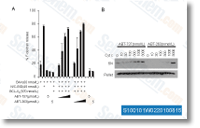Then again, yet another 20 genes had been located for being linked with DDR for that first time in this review, and the identities of corresponding mutants have been double checked. Amongst 20 genes, ten genes have already been by now identified to perform in numerous biological processes, which includes biosynthesis, RNA processing, anxiety response, transport and chromatin modification. Notably, deletion of trk1, a gene encoding the potassium ion transporter, induced powerful sensitivity to virtually every one of the DNA harm reagents utilized in our assay. There was no assigned perform for the remaining 10 genes, they had been classified as sequence orphan, conserved hypothetical or position inferred from homolog. Our information supplied novel func tional annotations for these unknown genes. Interes tingly, deletion of psl1 and SPAC19A8. 11c brought about sensitivity to only one reagent, suggesting these genes are demanded for repairing a specific DNA lesion.
Between these 20 novel DDR genes, eleven genes have homo logues in S. cerevisiae. selleck inhibitor Notably, deletion of 5 homologous genes are delicate to DNA harm reagents in S. cerevi siae, which displays the practical conservation of those DDR genes in fungi. Cell cycle examination of DNA injury sensitive mutants S. pombe genome is extensively annotated making use of terms from your Gene Ontology Consortium, with 98. 3% of its genes acquiring no less than one particular GO annotation. The GO term classification of 52 genes was carried out having a signifi cance degree smaller sized than 0. 05, and representative GO terms had been proven in Figure 1. This analysis revealed the 52 genes had been substantially enriched in cell cycle and chromatin connected processes. Because the most more than represented GO term, cell cycle was annotated to 36. 5% of genes. Cell cycle handle is probably the crucial elements with the DDR network.
Soon after DNA harm, the cell cycle is delayed by checkpoint to provide a chance for restore. To monitor the cell cycle transform while in the deletions upon DNA injury, the full report the DNA articles of 52 mutants was analyzed by flow cytometry. As anticipated, 37 deletions exhibited abnormal cell cycle profiles just after DNA harm. No modify was observed for your remaining 15 mutants, almost certainly thanks to insufficient time for therapy.  Based mostly on flow cytometry phenotypes without the need of reagent therapy, the 37 mutants may be divided into 4 groups which had been designated as 2C, 1C, W4C and S4C, respectively. Repre sentative cytometry information of each group are proven in Figure 2A. 2C stands for 2C DNA information. Members of this group, 16 deletions in complete, exhibited DNA content peaks at 2C with out reagent treatment, exactly the same as WT cells. On the other hand, peaks moved in direction of 1C upon DNA damage brought on by HU or MMS, suggesting that these deletions could cause replication arrest in response to harm. The concentra tffected the outcomes of our screen.
Based mostly on flow cytometry phenotypes without the need of reagent therapy, the 37 mutants may be divided into 4 groups which had been designated as 2C, 1C, W4C and S4C, respectively. Repre sentative cytometry information of each group are proven in Figure 2A. 2C stands for 2C DNA information. Members of this group, 16 deletions in complete, exhibited DNA content peaks at 2C with out reagent treatment, exactly the same as WT cells. On the other hand, peaks moved in direction of 1C upon DNA damage brought on by HU or MMS, suggesting that these deletions could cause replication arrest in response to harm. The concentra tffected the outcomes of our screen.
Anhydrase Signal
Renal carbonic anhydrase allows the reabsorption of bicarbonate ions in the proximal tubule.
